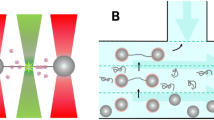Abstract
Fluorescence microscopy is a field of growing applications in various fields as it can be used to study immunofluorescence, fluorescent proteins techniques, live-cell imaging and many more. The present investigation is based on this single molecule observation technique to observe the effect of N-arylhydroxamic acids on λ plasmid DNA and linear Bacteriophage T7 DNA. The compounds under present investigation include N-1-naphthyl-o-methylbenzohydroxamic acid, N-1-naphthyl-p-methylbenzohydroxamic acid, N-1-naphthyl ethoxy benzo hydroxamic acid, N-1-naphthylphenylacetohydroxamic acid and N-1-naphthyl valero hydroxamic acid. The hydrodynamic radius, R H of λ DNA and long-axis length, l of T7 DNA were determined from the direct observation of Brownian motion of the DNA molecules in the absence and presence of hydroxamic acids. Folding transition was observed for λ DNA as well as T7 DNA in the presence of naphthyl hydroxamic acids. N-1-naphthylvalerohydroxamic acid was found to be most effective.







Similar content being viewed by others
References
Rigler R, Mets U, Widengren J, Kask P (1993) Fluorescence correlation spectroscopy with high count rate and low background: analysis of translational diffusion. Eur Biophys J 22:169–175
Takeshita F, Murai K, Iyama S, Ayukawa Y, Suetsugu T (1998) Uncontrolled diabetes hinders bone formation around titanium implants in rat tibiae. A light and fluorescence microscopy and image processing study. J Periodontol 69:314–320
Liu SC, Yi SJ, Mehta JR, Nichols PE, Ballas SK, Yacono PW, Golan DE, Palek J (1996) Red cell membrane remodeling in sickle cell anemia sequestration of membrane lipids and proteins in Heinz bodies. J Clin Invest 97:29–36
Kassies R, Van Der Werf O, Lenferink A, Hunter CN, Olsen JD, Subramaniam V, Otto C (2005) Combined AFM and confocal fluorescence microscope for applications in bio-nanotechnology. J Microsc 217:109–116
Cherukuri P, Bachilo SM, Litovsky SH, Weisman BR (2004) Near-infrared fluorescence microscopy of single-walled carbon nanotubes in phagocytic cells. J Am Chem Soc 126:15638–15639
Robins B, Tysseland M (1983) The geology, geochemistry and origin of ultrabasic fenites associated with the Pollen Carbonatite. Chem Geol 40:65–95
Crelling JC (1983) Current uses of fluorescence microscopy in coal petrology. J Microsc 132:251–266
Khare D, Pande R (2012) Experimental and molecular docking study on DNA binding interaction of N-phenylbenzohydroxamic acid. Der Pharma Chemica 4:66–75
Gupta VK, Tandon SG (1972) Preparation and properties of N-1-napthylhydroxamic acids. J Chem Eng Data 17:248–249
Yoshikawa Y, Yoshikawa K (1995) Diaminoalkanes with an odd number of carbon atoms induce compaction of a single double-stranded DNA chain. FEBS Lett 361:277–281
Yoshikawa K, Matsuzawa Y, Minagawa K, Doi M, Matsumoto M (1992) Biochem Biophys Res Commun 188:1274–1279
Sato YT, Hamada T, Kubo K, Yamada A, Kishida T, Mazda O, Yoshikawa K (2005) Folding transition into a loosely collapsed state in plasmid DNA as revealed by single-molecule observation. FEBS Lett 579:3095–3099
Oana H, Tsumoto K, Yoshikawa Y, Yoshikawa K (2002) Folding transition of large DNA completely inhibits the action of a restriction endonuclease as revealed by single-chain observation. FEBS Lett 530:143–146
Houseal TW, Bustamante C, Stump RF, Maestre MF (1989) Real-time imaging of single DNA molecules with fluorescence microscopy. Biophys J 56:507–516
Flory EJ (1969) Statistical mechanics of chain molecules. Wiley, New York
Acknowledgments
Authors are grateful to the University Grants Commission, New Delhi for providing financial support under SAP program [grant number F – 540/9/DRS/2010].
Author information
Authors and Affiliations
Corresponding author
Rights and permissions
About this article
Cite this article
Singh, P., Pande, R. DNA Folding Transition in Presence of Naphthylhydroxamic Acids as Revealed by Fluorescence Microscopic Single Molecule Observation Method. J Fluoresc 26, 67–73 (2016). https://doi.org/10.1007/s10895-015-1661-7
Received:
Accepted:
Published:
Issue Date:
DOI: https://doi.org/10.1007/s10895-015-1661-7




